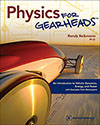|
Now Available! |
Physics for Gearheads
Price: $119.95
|

Hot Rod Engine Tech:
The High Performance Engine Builder's Technical Resource - June 14 2015
Book Review
As gearheads most of us possess a relatively keen understanding of how automotive systems function. We came by it largely through observation and examination of the various parts and assemblies along with word-of-mouth explanations from friends, mechanics, books and various other resources. Some functions and processes seem relatively intuitive on the surface, but there are solid scientific reasons and explanations for all of them. A new reference book, Physics for Gearheads by Randy Beikmann PhD. provides the detailed explanations you need to fully understand the intricate mechanical functions of high performance automobiles and race cars.
"There is no better way to learn physics than by having a difficult problem to solve."
Diehard gearheads enjoy a hidden advantage when it comes to understanding physics because the magic of it is revealed and demonstrated to them every day in their jobs, projects and even motorsports events. The experience you already have building and tuning cars or motorcycles is equivalent to you own personal Physics 101 lab. Physics for Gearheads completes the course by explaining the basic physics behind the automotive functions you are already familiar with.
Whether your interest is in increasing your engine's horsepower, getting more miles per gallon, or shaving tenths off your lap time on track day, you can use physics to understand the problems and determine the most effective solutions. Physics for Gearheads not only explains physics principles in language you can understand, it demonstrates how to use physics to your advantage to increase your car's performance and even improve your driving skills for racing.
Physics for Gearheads allows the reader to work in SI or British Engineering units so those unfamiliar with the metric system can follow easily and slowly incorporate it into their knowledge base. The accompanying list of chapters sounds daunting at first , but it simply describes physical functions and properties that apply to all your performance requirements. Some of it will require you to think a little harder, but it becomes almost second nature as the author reveals the scientific principles that govern everything you do.
Engine guys will appreciate the wealth of formulas and equations defining critical functions such as mean piston speed and acceleration and the effects of rod ratio on power and torque production. The underlying greatness of this book is seen in the simple explanations of complex subjects and concepts and how to incorporate simple basic math to describe your own problems and derive effective solutions.
The book describes how and why your car runs, makes power, accelerates, corners and brakes under varying road conditions including the race track. It presents specific formulas for the "ideal drag racer" to apply in the pursuit of lower ET's and higher trap speeds. It thoroughly dissects the mechanics of road racing and oval track performance based on statics, center of gravity, weight distribution and load transfer.
There are 17 chapters and more than 600 pages describing every aspect of vehicle dynamics and motion, force and vectors and all the core science that makes a car perform. Multiple appendixes, an in-depth glossary and detailed index permit quick navigation to the topic of your choice. This book is destined to become the new bible of performance engineering for the regular guy. You will refer to it over and over again and it will likely become thoroughly dog-eared addition to the rule books and cam cards in the top of your tool box. The author's style is engaging without the intimidation that often accompanies a read of this nature.
This book is a "Must Read" for every gearhead, car guy and performance enthusiast.

Review from and courtesy of Hot Rod Engine Tech - June 14 2015
![[B] Bentley Publishers](http://assets1.bentleypublishers.com/images/bentley-logos/bp-banner-234x60-bookblue.jpg)
